If there is a tank at the toilet with a button, it is not necessary to call for plumbing. The tank leaks from the toilet, as a rule, in the attachment points. With such a breakdown, you can manage with your own hands. Leakage means only one thing - the tank of your toilet is defective. There are a lot of reasons for the leak. Today we will look at the most common ones that were only encountered in practice. Of course, together with this we will tell you how to solve the problem. It is noteworthy that the design of the waste tank was invented long ago. For many years his device remained virtually unchanged. Only the materials used in production were changed. Alas, the change did not go to the best in terms of reliability, quality. Agree, the metal is much stronger than the current plastic. But these elements are easy to change, repair, dismantle. So there are advantages in plastic.
- 1 A little about the principles of work
- 2 Common breakdowns and ways to eliminate them
- 2.1 Water is continuously supplied to the tank
- 2.2. The water in the toilet does not stop flowing
- 2.3 You have a toilet bowl leaking due to the loss of the elasticity of the pear
- 2.4 Pear keeps water from the saddle
- 2.5 On the basis of overflow weakened the nut
- 2.6 Leakage of the cuff
- 2.7 Actively flows between the drain tank and the toilet bowl
- 2.8 Cracks in the drain tank
- 2.9 Shut-off valve does not retain water
- 2.10 The knob height control has shifted
- 2.11 Water flows at the junction of the tank and the water hose
- 2.12 Fastening of the armature is broken
A little about the principles of work
To begin to consider the main malfunctions, let's recall how the tank works.
So, water on the water pipe begins to flow into the tank, filling it. At the same time, the float rises. Draining is carried out thanks to the well-coordinated work of the float, seals and levers. Having accumulated in the tank to the required volume, the water closes the shut-off valve, thereby stopping the water supply to the tank. We press the drainage lever, or the button, pull the chain, which opens the drain valve, and a large volume of water rushes down, thereby draining. But the trouble is, it flows, and you do not know what the problem is. Do not worry, almost every malfunction can be eliminated in a few minutes. Moreover, sometimes a leak does not require the replacement of any elements. That is, you do not have to spend money.
When preparing for repair, you will need to equip yourself with gloves, nippers, pliers, and new elements to replace old ones. After all, when the toilet bowl flows, do not hesitate. After all, you yourself know what the bills for water are now.
Common breakdowns and ways to eliminate them
Water constantly enters the tank
This may be caused by a skewing of the float lever, damage or malfunction of the float valve.
How to fix. You need to install the float lever horizontally, replace the valve or the float itself. If there is no float for replacement, simply seal the float with hot plastic. An even simpler option is to wrap the float in a cellophane bag. It is important to completely isolate it from contact with water.
Water in the toilet does not stop flowing
Obviously, the siphon membrane is damaged.
How to fix. It is only necessary to replace the membrane, since it will not be possible to repair the old one already. To do this, replace the lid of the tank with a crossbar (stick any), attach a float lever to it, unscrew the lock tank and the flushing pipe nut. Now you can detach from the lever your siphon, which should be placed a new membrane, which in size corresponds to the old one. After completing the repair, collect all the reinforcement back.
You have a toilet bowl due to the loss of elasticity of the pear
Alas, rubber pears are very short-lived. Over time, they lose elasticity, become rigid, completely inelastic. Because of this, it can not tightly touch the saddle, thereby it begins to flow.
How to fix. The only way out in this situation is to change the old pear, setting a new one in its place.
Pear keeps water from the saddle
Pear sits on the saddle, thereby retaining water, but over time, the appearance of corrosion and plaque on the saddle leads to a deterioration in the landing. As a result, it begins to flow.
How to fix. To do this, you need to detach the pear, carefully clean the saddle from dirt. Here sandpaper helps a lot. In addition, it is recommended that you tighten all nuts and fasteners.
On the basis of overflow weakened the nut
Not a rare reason for the formation of leaks.
How to fix. Here everything is quite logical. Once the nut has loosened, it is necessary to remove the elements that prevent access to it and tighten it.
Leakage of the cuff
Cuff problems are not uncommon, as it connects the toilet bowl to the tank.
How to fix. Try putting the cuff on its original place. If it does not work out, tighten with a clamp. Take into account, over time, the cuff can break, thus even the yoke does not help. The only way out is to buy a new one and put it in its place.
Active flows between the drain tank and the toilet bowl
The reason can serve as gaskets, which are made of rubber. Long-term exploitation leads to their prohibition, displacement. Sometimes they just were incorrectly inserted.
How to fix. Everything is quite simple - the gasket between the tank and the toilet is removed, a new, high-quality one is taken, and put in the right place.
Cracks in the drain tank
The problem is quite serious, but you can cope with it without resorting to replacing the entire toilet.
How to fix. Remove the drain tank, drain thoroughly, and then detect the cracks found with a high-quality sealant. This is a fairly effective method. Of course, you can not hold a sealant forever, but it will be enough until you collect money to buy a new toilet bowl.
The check valve does not hold water
To detect a valve breakdown is simple - press it lightly with your hand, as a result of which the water stops flowing. If the water flows further, then the valve is broken.
How to fix. Serious tasks such a failure does not put, because you only have to change the gasket in the faulty valve.
The knob height control has shifted
As a result of the displacement, the valve is located higher than the drain opening. This leads to the appearance of a gap through which a leak is observed.
How to fix. Adjust the height of the button.
Water flows at the junction of the tank and the water hose
How to fix. Try to tighten the nut. Maybe she cracked. In this case, simply replace the damaged nut, use sealants.
Fixing of armature is broken
How to fix. If you find that the mounts are completely broken, then the reinforcement will have to be changed completely. Remove it, take it with you to the sanitary ware shop, where you will find similar consumables.
As you can see, the tank can leak for many reasons. However, most of them are easily eliminated. Try to deal only with quality plumbing, which can last for many years without giving you trouble.
Of course, no plumbing is eternal, because sooner or later problems will arise. Well, you will already know how to deal with them.
When the toilet starts to flow, there is no reason to feel joy: the noise causes irritation; the counter winds up large numbers, which will have to be paid; on the toilet itself there are traces of rust; Condensation occurs on pipes and walls, which in the short term threatens to result in corrosion, mold and decay. And in order to avoid negative consequences for your nerves and home, and for your wallet, you should start solving the problem as quickly as possible. Fortunately, most cases when there is a leak from the tank to the toilet, easily corrected, and deal with them can be done on their own. A simple solution to the problem of leaking from the tank to the toilet is cheap and angry you can see on the video (in its own way it shows the wit in correcting the problems):
Why does the water flow from the tank into the toilet bowl
It can not be said that there is only one reason for the leak, and the solution to the leaking problem is this. A possible reason can be special for each particular design. But nevertheless, we have spread the "classical" design, and the consideration of leakage problems, as well as their elimination, will be considered on it. Also, I propose to watch an informational video that will allow you to understand the design feature of the toilet flush tank to better understand the nature of the leaks:
Why the tank has a leak №1
The most popular reason is very obvious - the toilet bowl is completely overflowing, and all the excess water leaves through the overflow. And this reason has several of its causes that lead to it:
- Deformation of the rubber gasket during operation, when the rubber loses its elasticity and because of the loose overlapping of the water, it starts to flow.
- Insufficient level of pressing the gasket to the outlet of the drain valve. It was not deformed and did not lose its elasticity - the gasket just weakly presses against the toilet parts and because of this the water flows.
- Rusted or frayed in use pin, holding the float in the valve body.
- The body crack of the drain valve inside the toilet bowl, through which there is a leak.
Attention please! If a brass valve is used in the reservoir, then point number 4 should not be taken into account, since cracks are the lot of plastic parts, brass ones are too reliable.
Brass valves look like on the photo:
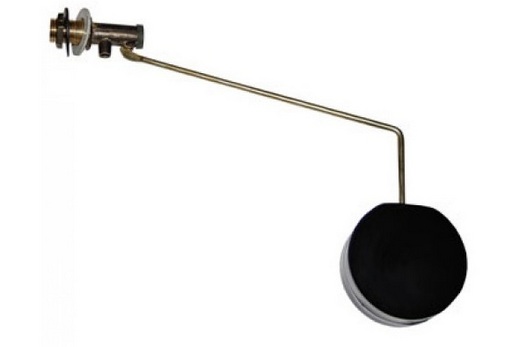
Why the tank has a leak №2
If the tank is not full, but there is a leak - what is the reason for the leak in the toilet bowl? The second popular reason for leaking is the problem with the bolt connecting the tank and the toilet itself. Steel bolts rust and give leakage, plastic burst and water starts to leak.
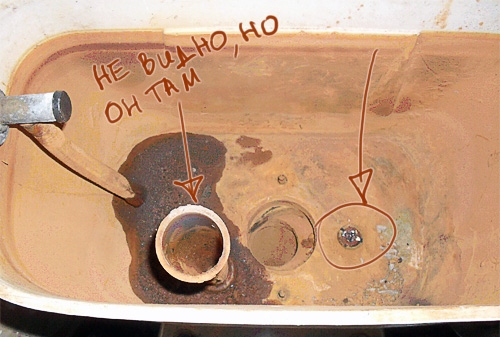
Why does the tank leak?
Another popular reason for leaking is the problem with the rubber pear. The fact is that the pear, like any rubber part of the toilet bowl, loses its elasticity with time, becomes more rigid and no longer takes the necessary shape, as a result of which the water begins to leak. You can find it by following this photo:
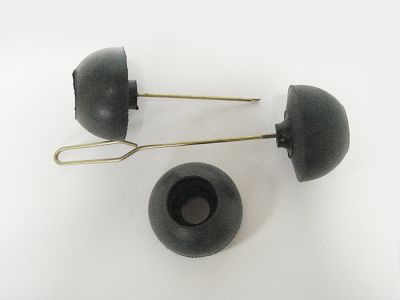
Why does the tank leak?
It may also be that the drain tank malfunction due to skewing or shifting of the float arm. There are a lot of grounds for skewing: so it can have a hole, due to which the float dries water, or simply moved in the process of active operation. Or buying plumbing parts, the quality and length of service, which, as well as the possibility of leaking from the tank, can not be said.
Ways to eliminate leaks from the toilet bowl
But if there are reasons why water flows from the tank into the toilet, then there must be ways to prevent this unpleasant and unprofitable action for the purse. Now you can get acquainted with the best ways to overcome the trouble, when the water flows from the tank to the toilet.
The solution of the problem created by reason # 1
Solve the problem, when the water leaks can be easily enough, to know only what root cause is to blame for the water from the tank to the toilet. It is necessary to conduct a small experiment:
- Remove the lid of the toilet;
- Raise the float by one centimeter. If the water stops flowing, the goal is reached. The problem is a slightly bent lever float, which now does not block the water, and it continues to flow. To fix the leak, it is enough to bend it slightly so that the lever covers the water more precisely, when approaching the filling face.
- If the leak from the tank to the toilet did not stop, then you should inspect the valve itself. Make sure that the fixing pin is in place, it is intact and when used fixes the float lever in the valve. Also, check the hole on which the pin is held: Is everything normal and as it should be?
- If the hairpin really collapsed, it can be replaced with a piece of thick copper wire. If the hole for it is deformed, then you should go to the store for a new valve.
- Do you read this paragraph because others have not come up? Okay, you need to press the gasket against the valve hole. If the water stops flowing when pressed, it means that the gasket is slightly pressed, it is necessary to adjust it. With the continuation of the leak from the toilet, you need a new gasket.
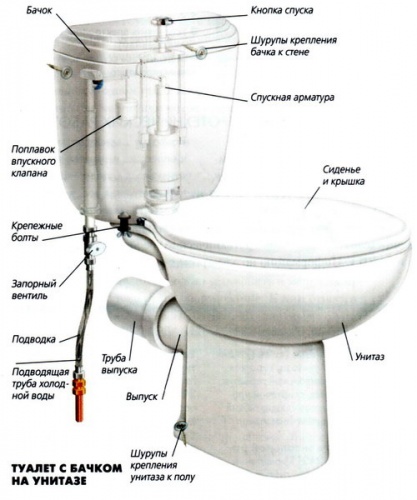
When examining the reasons and ways to solve the problem it was believed that the toilet bowl has a classical design that has been used for 30-40 years. But given the continuous appearance of new designs of toilets and their tanks, you can recommend to familiarize yourself with the principle of their functioning.
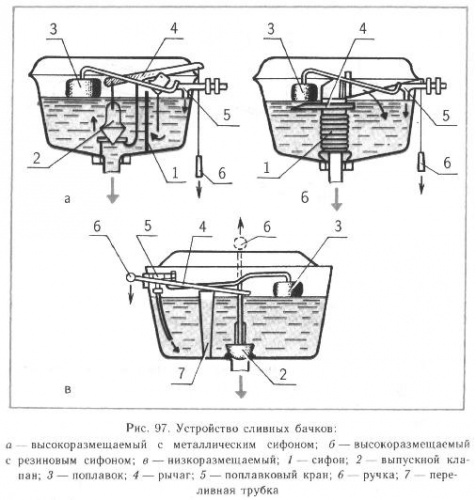
Elimination of the reason number 2
First, carefully inspect the valve. It may be necessary to replace only a few bolts. But just in case it will be better to buy a new toilet kit, because it's quite cheap. In any case, you should completely disassemble the toilet bowl to understand why it is leaking and why it is leaking. So, if you identify problems that are not noticed with the naked eye, you will be only glad that you have bought a complete set of bolts. Replacement process:
- Disconnect the water supply to the toilet bowl;
- Empty the tank;
- Disconnect the flexible liner from the toilet bowl;
- Unscrew the bolts. If they are covered with rust, it is better to cut them with a hacksaw. The purchase of bolts is always cheaper than a broken toilet because of a large amount of effort;
- Pushing the toilet bowl back, you must pull the shelf off the cuff, which connects it to the toilet;
- Drain the rests of water and remove rust from all places where it is only found;
- Repeat all the steps in reverse order, only with the new bolts and it is advisable to replace them with new rubber gaskets, even if they have not yet deformed enough to allow water to pass through
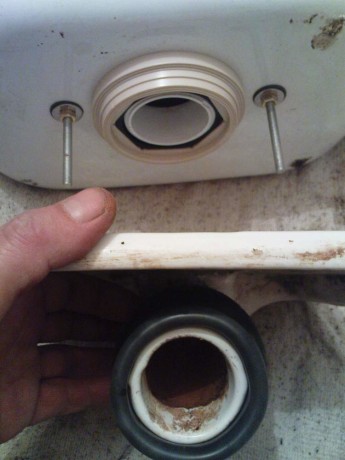
A warning ! When you tighten the bolts, try to avoid even the slightest distortions, and avoid applying significant effort. To crush faience from which a toilet bowl is made, or leave a crack on it very simply.
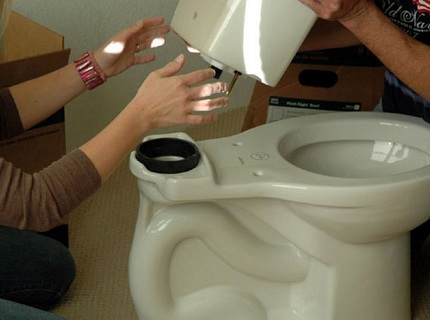
Work and elimination reason number 3
Since the pear has already lost its shape, its repair does not make sense to eliminate the problem from the economic point of view. The way out is to buy a new pear. In the store, you should ask several pears at once, and choose the softest of them, because eventually they all become tougher (you can see from your own pear). The pear is fastened with the help of a thread, and if viewed from above, to unscrew it, turn it clockwise to remove it, and against it to tighten a new one. A temporary solution to the problem with the pear can be a load suspended on the rod, which will press the pear to the saddle. Any weighty nut can fulfill the function of this load. I propose to look at the photo where such a decision is played:
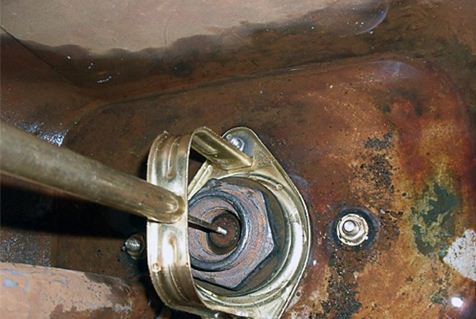
Solution to Problem # 4
In the case of buying a substandard float, the solution is only one - to buy a new float, a better one. If a small hole is formed, then it can be sealed with conventional polyethylene or a plastic heated with a lighter. To be honest, such repairs can only be considered as a temporary measure. After a certain time, you still have to buy a new float.
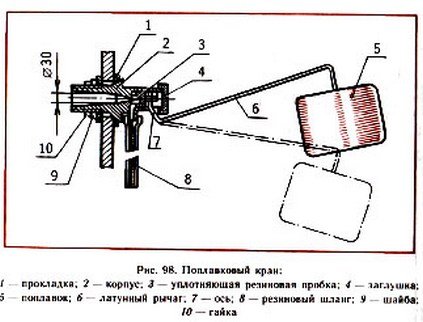
Conclusion
During the study of the article you could get acquainted with the most popular problems of the drain tank that arise during the operation of the toilet bowl. But this is not the end - for you there was a small information piece. Finally, I propose to watch a full video tutorial on how to repair the tank, which is:
The design of the toilet bowl - the device is not very complicated. For its repair, you can, of course, turn to specialists. But it's better and cheaper if you have the skills to work with a tool, do repairs yourself. It will not be very difficult.
The design and operation principles of the waste tank
The drain mechanism of the toilet bowl is divided according to the type of water drainage. There are models in which when the lever is lifted or the button is pressed, all water descends into the bowl of the toilet bowl, flushing into the sewage canal. In more modern models, the economy is thought out. That is, two buttons - when you press one, the tank empties completely, while pressing the other - the part of the water comes down.
Despite this, the inside of the tank of any type is almost identical.
The siphon for the drain tank consists of several levers, a pear, a float, valves, a button and gaskets. The drain in the toilet works according to the principle of hydraulic shutter.
Water, filling the tank, pushes the float, and it gives a "signal" to the shut-off valve to block the water intake. When the user presses the button, the drain cock opens and the water descends. This is how the drainage occurs.
The drain tank does not hold water. What to do? Focus on the four main elements of the drain system: valve, overflow, draining lever and tap.
Float valve (or valve) is a part connected by a connection with a supply hose. It is attached to the locking unit, which is controlled by a float. If the tank is empty, the float pulls the locking piece down and the choke opens. The float floats up when the tank is full and closes the choke.

Trigger valve - a special hatch, fixed on the hinge. It closes the drain hole. When the hatch is closed, the float cock opens and the tank starts to fill. When it is open, the water merges into the toilet bowl.
Overflow - hollow column, directly connected to the toilet hole. The main function of this element is to protect the drain tank from overflow.
The drainage lever is the system that controls the water drain valve. Its main element is a holder with a rocker, which is connected to the valve (hatch) at one end. The user presses a button that presses against the loose end of the rocker, opening the hatch. When the button is released, the rocker arm and the hatch return to their original position.
The drain tank with the bottom water supply has a slightly different structure, but the elements requiring replacement or repair are the same as on the drain tank with side water supply.

Preparatory work
For repair work in the drain tank may need a pair of pliers, working gloves (preferably rubber), nippers and spare parts.
Before repair work, you need to close the tap at the entrance to the tank.
On most modern toilet bowls, a flush button is mounted in the lid. Naturally, before removing the cover, you need to detach the button and the decorative ring. After disconnecting the button mechanism, the ring is removed (easily poddervaetsya any sharp object). If the tank is fixed with fasteners, they are dismantled.
In the case of a two-button flush system, the buttons are pressed alternately and scrolled until disconnected.
It should be noted that the lid of the tank is not considered a spare part and is not sold separately. Therefore, you should treat it with extreme caution.
Flowing the drain tank: possible causes
Quite often it happens that the water in the tank does not hold and constantly flows into the toilet. This happens most often because of a poor quality siphon or other fittings, depressurization of plastic parts of the siphon or loss of elasticity of the pear. The main reasons can be several. Here are some of them:
- petal or pear adjoins not tightly;
- the work of the tank ball-cock is not adjusted;
- the connection of the ball valve and hose is not sealed;
- the connection between the toilet seat and the tank is not sealed.
So, the drain tank does not hold water, what should we do? Let's try to figure it out.
You need to start with a visual inspection of the valve and siphon for chips, cracks and other noticeable damages.
Damaged membrane
Most often, the water leaks in the toilet because of a malfunction of the membrane. It can not be repaired. Therefore, it must be replaced.
To this end, removing the lid of the tank, you need to place the crossbar on its walls and fix the lever of the float on it. Then, the locknuts that connect the tank to the flushing pipe are dismantled. Then it becomes possible to disconnect the siphon from the float lever and replace the membrane.
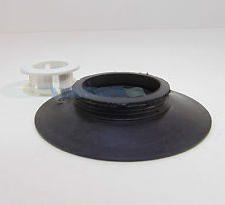
Pear lost elasticity
If the drain tank does not hold water, what should I do? Be sure to check the elasticity of the pear. The manufacturer warns that its work is short-lived, as rubber can not remain elastic for long. After a while it becomes rigid and does not keep a tight connection with the saddle, as a result of which water begins to seep. The solution to the problem is to replace it with a new one.
If the deformation of the pear is insignificant, you can use the advice of specialists. Temporarily (before the replacement), it is heavier, planting on its axis, holding it, several stainless nuts.
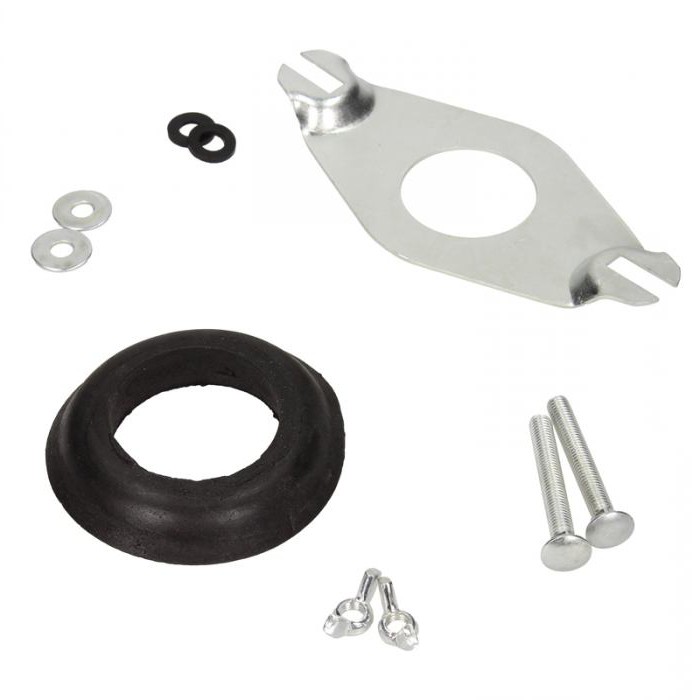
The saddle should hold the pear tightly. But in the process of operation it can form plaque or corrosion, and the pear does not fit tightly. As a result, water finds a way out.
You can fix it as follows. Remove the pear and clean the saddle thoroughly. You can use fine sandpaper. When assembling, special attention should be paid to the fasteners and nuts.
The reason for the uselessness of the bolts restraining the saddle
If the drain tank does not hold water for this reason, the repair is carried out according to the following scheme. First, the water is completely removed. Then, between the flexible hose and the valve, the float is unscrewed, bolts securing the toilet bowl to the tank are removed. Further, slightly bending the tank, release the corrugation, connecting it with the toilet.
Now the bolts are dismantled: both are necessary, even if one has come to be worthless. In their place are mounted new (brass or stainless). Tighten carefully, without making any special effort and avoiding shifts and distortions. Now you can assemble the structure and use it.
The shut-off valve is broken
It is not difficult to detect this breakdown. The valve should be pressed by hand. Ideally, water should stop leaking. If it continues to leak, the valve is defective. The solution to the problem is the replacement of the valve.
Independently it can be done as follows.
Empty the tank. Carefully remove the cover, after removing the button. Next, move the float arm together with the float (if they are not an integral structure). Now you can turn off the hose adapter and disconnect the water pipe and the external fitting.
Further loosens the nut inside the tank, pressing the valve (valve). Then the outer nut is twisted, which fixes the body of the valve inside the tank. Now it is easy to dismantle the broken part and put a replacement (preliminary on its fitting the inner nut must be screwed). Screw the outer nut, pressing the hidden one. Then connect the water hose and drain the water.
What else to look for if the drain tank does not hold water? Probably, the reason is in the deviation of the height adjustment knob of the trigger button. The shift of the valve relative to the opening of the descent leads to a stable leakage of water. To solve this problem, adjust the height of the valve in accordance with the instructions attached to the siphon.
If the problem persists, you will have to completely replace this part of the drainage mechanism.
The tank continuously picks up water
![]()
The malfunction is that the float lever has shifted or skewed. The fix is quite simple: lower it below the incoming water pipe (at least 2.5 cm). And thoroughly fix all the fasteners.
If the float in the drain tank on the plastic lever, then adjust it by tightening or loosening the screw. Or, in some models, the adjustment is made using a plastic ratchet.
If its adjustment does not solve the problem, you need to inspect the pin, which holds the lever of the float. Perhaps it broke. In this case, it can be replaced by a piece of wire (preferably copper, steel will rust) of the same thickness.
The hole in the plastic valve, which includes the stud, is also prone to wear. In the process of work, for example, it can become oval. This repair failure does not lend itself. Plumbers are advised to remove the valve to show in the store and buy an identical one.
Perhaps because of the float the drain tank does not hold water. How to repair it? If it is heavier because of the accumulated water, it must be drained, dried and treated with hermetic cracks or crevices. After repair, the part is put in place. This is a temporary solution to the problem. Ideally, you need to replace the float.
Trouble in the trigger
The most frequent malfunction in the trigger is an unregulated overflow. In the case where his tube is not high, and the float allows you to get water above this level, you can fix the problem by simply setting the level of filling the tank.

So, the drain tank does not hold water. What to do? The scheme is simple. It is necessary to lift the overflow pipe (it easily extends upwards). Then there are two possible scenarios.
First. If the water stops flowing, and leaves through the overflow tube, then raise the tube and the problem is solved. And the second. If the overflow tube is at the maximum level (which threatens to overflow water), then lower the float slightly.
When the toilet bowl is not holding water, it is very unpleasant. Firstly, the sound of water is constantly heard. Secondly, the consumption of the meter is increased, that is, it turns out that the money flows into the sewer. But you can correct the situation.
Tools and materials
If it is already clear that the toilet bowl is not holding water, then you have to start repairing it. But it is impossible to say in advance which parts can be required. Therefore, it is best to start with a diagnosis and then, having all the information, go to the sanitary ware shop.
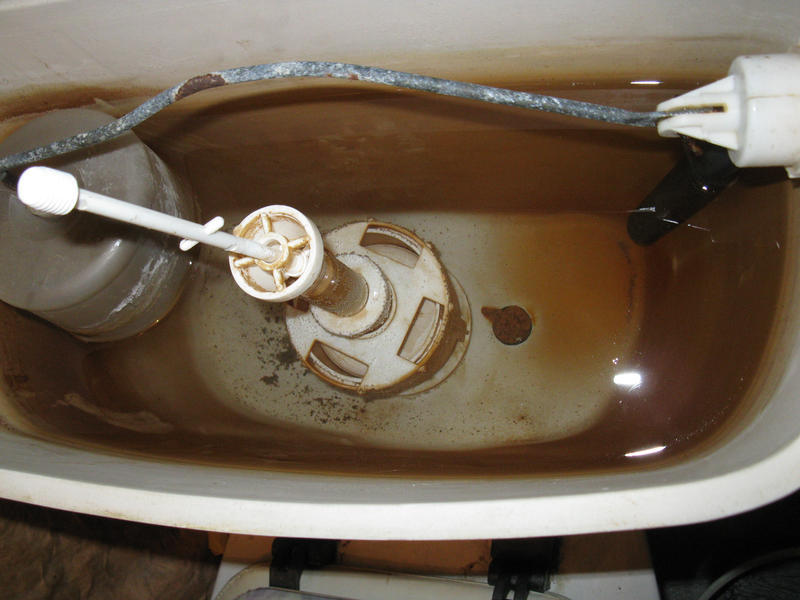
Sequence of work
The most common problem lies in the exhaust valve. Manufacturers use rubber for the production of its main gasket, which will eventually "age" and wear out. The solution to the problem will be to replace the old part with a new one. It is better to look for a silicone gasket, which has a longer service life, due to its high plasticity.
Also, the toilet bowl does not hold water when the location of the float is violated. Then the water begins to reach the overflow level, and, accordingly, flows down. Carrying out of adjustment works will allow to solve this problem:
- For older models, the correct installation of the float is done manually. For this purpose, the rocker is simply bent until the float is lowered to the desired level. It is considered correct when the water does not reach a 1-2 cm overflow.
- Modern equipment is regulated differently. In order to return the float to its place, it is necessary to use the adjusting screw.
As another reason, you can consider the option when the float itself comes into disrepair. Its damage leads to the fact that it ceases to act as a regulating element. It happens that it is necessary to change the entire trigger system, which is not very difficult, due to the fact that the design does not differ with particularly sophisticated schemes.
So, if you have problems with the current water toilet, first check all gaskets. And in the case of their serviceability test the main working nodes and replace those that are out of order.
Video on replacing the toilet valve with a toilet bowl
Not many people attach importance to the fact that the toilet bowl flows, until they get a bill for water. That's when a certain concern arises - after all, every drop of water has to be paid, and nobody likes it when precious moisture simply flows into the toilet.
In order to cope with the problem, you can contact a specialist or try to eliminate leakage yourself. We will see how to determine the problem of the waste tank and quickly solve this issue without resorting to outside help.
The main types of tank leakage.
There are several problems that cause increased water consumption:
The water overflows. The liquid constantly leaks from the mechanism of the tank into the toilet, while the float does not hold it inside.
The water flows past the toilet. The leak is formed between the bowl (shelf) and the drain tank, which will bring inconvenience to your neighbors if it is not eliminated in time.
Flows when draining water. In this case, the leakage is not constant, but, attention, only in those moments when it is necessary to drain the liquid from the tank into the bowl.
Depending on what kind of problem your plumbing, you need to select and methods of struggle. Thus, you can effectively combat the malfunction.
What to do if the tank does not hold water.
When the toilet bowl flows with water overflow to the toilet, the main cause of the breakdown is usually hidden in the drainage mechanism. To eliminate it you need:
Shut off the water supply. It is known that after draining the water is automatically recruited. To avoid this, you need to close the tap.
Open the lid of the tank. Modern plumbing allows easy access directly to the drain mechanism.
Check the float. It should be attached smoothly and move freely. Perhaps, it is because of it that the tank does not hold water - when it is dialed to the desired level, the float simply does not close the drain hole due to improper attachment.
Check if there is water in the float. Only in the event that the liquid is still there, it must be removed and the excess moisture removed. After this, it is necessary to seal a crack through which the liquid got inside by any convenient method (sealant, silicone, soldering iron).
Check the float valve, in case of breakage it will be necessary to replace it. The algorithm is simple - all the fixing nuts are loosened, after which a new valve is fastened to the old part using the same fasteners. When selecting the mechanism, pay attention to the valve class - it can be designed for a strong, medium and weak pressure of water. If you pick up the valve incorrectly, even in good condition, it will not keep the hole closed when water is dialed to the desired level.
This is just a few reasons that lead to the fact that the tank does not hold water. However, the rest are more complicated - to solve them, it is better to contact a specialist if you do not have the experience of plumbing work. You can find an inexpensive master, for example, on Yudu's site - lay out an application with the text "The tank does not hold water", after which the specialists will start offering their services, one will only have to choose one of them.
How to deal with what flows the toilet bowl in the place of attachment to the bowl.
Another frequent type of breakage is the leakage between the tank and the bowl. Usually it occurs on the toilet, where the tank is directly attached to the bowl. The main reasons and solutions:
Malfunction of the cuff. You can check this assumption visually or with a normal piece of toilet paper - where it gets wet, it flows there. The problem can be solved by replacing the cuff, special clamps or scotch tape. The latter is still a temporary measure. It is best to either install a new cuff or purchase a special clamp.
Poor mounting of the drain tank. To solve the problem, simply tighten the bolts with a wrench. But be careful - do not overtighten the bolt and do not rip off the thread. Otherwise, you will have to buy new fasteners.
Worn shims. It is impossible to correct the old ones. It is necessary to change. They cost very inexpensively, and the effect can be magnificent. For replacement, unscrew the bolts, remove the reservoir and secure the new gaskets.
Damage to the shelves of the toilet bowl, cracks in the drain tank. It can only be repaired with ceramic glue. But this is a temporary measure - sooner or later this toilet will still have to be replaced.
What to do if the tank flows when draining or when it is recruited.
There are often cases when pressing the sink, the owner of the apartment detects a characteristic seepage of water. This usually indicates a malfunction of the drainage mechanism inside the tank. To solve the problem, you should:
Check the locking of the check valve. Correct simply - find the device in the middle of the tank and press it lightly. Only if the water stops flowing, you just need to replace the gasket with a new one.
Check the tank fixing nut to the shelf or pipe. To fix the situation, you just need to tighten it. Also, sometimes replacement of fasteners is required - especially if the thread is broken.
Check the drain button. Thus, if the level is broken, it may prevent the closure from closing the opening. In this case, you just need to fix its level.
If this instruction did not give you an opportunity to find the cause of the leak, then most likely it is more complicated. In this case, it is best not to rely on your own knowledge and ingenuity, but to turn to a qualified plumber. This will save you valuable time and nerves - often a qualified expert can cope with the problem.
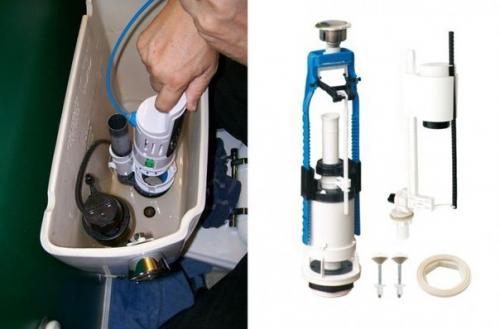
See more articles about repairing an apartment with your own hands
